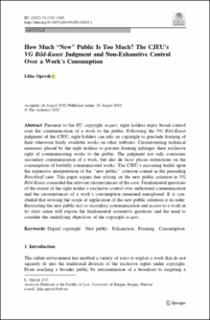How Much “New” Public Is Too Much? The CJEU’s VG Bild-Kunst Judgment and Non-Exhaustive Control Over a Work’s Consumption
Journal article, Peer reviewed
Published version

Åpne
Permanent lenke
https://hdl.handle.net/11250/3055074Utgivelsesdato
2022Metadata
Vis full innførselSamlinger
- Faculty of Law [2624]
- Registrations from Cristin [10237]
Originalversjon
IIC - International Review of Intellectual Property and Competition Law. 2022, 53, 1323-1342. 10.1007/s40319-022-01243-1Sammendrag
Pursuant to the EU copyright acquis, right holders enjoy broad control over the communication of a work to the public. Following the VG Bild-Kunst judgment of the CJEU, right holders can rely on copyright to preclude framing of their otherwise freely available works on other websites. Circumventing technical measures placed by the right holders to prevent framing infringes their exclusive right of communicating works to the public. The judgment not only constrains secondary communication of a work, but also de facto places restrictions on the consumption of lawfully communicated works. The CJEU’s reasoning builds upon the expansive interpretation of the “new public” criterion coined in the preceding Renckhoff case. This paper argues that relying on the new public criterion in VG Bild-Kunst concealed the relevant circumstances of the case. Fundamental questions of the extent of the right holder’s exclusive control over authorized communication and the circumstances of a work’s consumption remained unexplored. It is concluded that revising the scope of application of the new public criterion is in order. Restricting the new public test to secondary communication and access to a work in its strict sense will expose the fundamental normative questions and the need to consider the underlying objectives of the copyright acquis.
